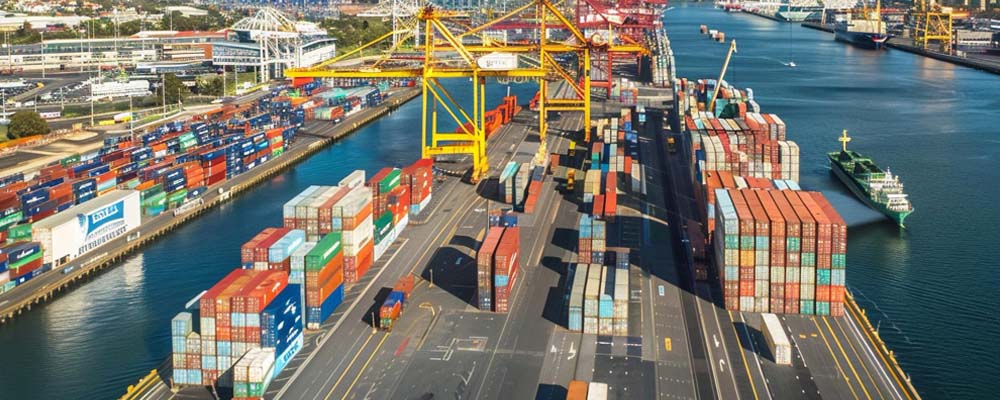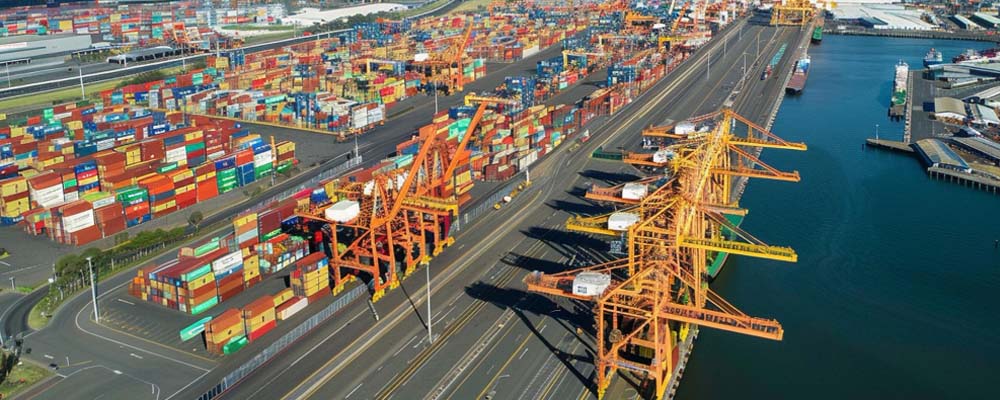
The Port of Vancouver stands as Canada’s busiest and most vital trade hub, connecting the country to the global market. For freight forwarding companies, logistics providers, importers and exporters, customs brokers, manufacturers, and e-commerce businesses, understanding the nuances of this port is crucial. This blog provides an in-depth look at the Port of Vancouver, highlighting its key features, economic impact, and tips for efficient navigation.
5 Key Features of the Port of Vancouver
1. Extensive Terminal Facilities
The Port of Vancouver boasts a wide array of terminal facilities designed to handle various types of cargo. From bulk cargo to containers and breakbulk, the port’s infrastructure ensures smooth operations for all.
Several specialized terminals cater to specific needs. For instance, the Deltaport Terminal is one of the largest container terminals in Canada, equipped with state-of-the-art technology for efficient handling. Additionally, the Westshore Terminals are dedicated to coal exports, underlining the port’s versatility.
The advanced facilities at the Port of Vancouver allow for streamlined loading and unloading processes, reducing wait times and improving turnaround times. This efficiency benefits every stakeholder in the supply chain, from manufacturers to end consumers.
2. Strategic Location and Accessibility
Situated on the west coast of Canada, the Port of Vancouver enjoys a strategic location that offers direct access to major Asian markets. Its proximity to key shipping routes makes it an ideal entry and exit point for North American trade.
The port is well-connected to the country’s extensive rail network, providing seamless inland transportation options. This connectivity ensures that goods can be transported efficiently to and from various parts of North America.
The port’s accessibility is further enhanced by its comprehensive road network, which facilitates swift movement of goods to regional markets. This combination of road and rail connectivity ensures that the Port of Vancouver remains a pivotal player in global trade.
3. Advanced Technology Integration
The Port of Vancouver leverages cutting-edge technology to enhance its operations and maintain a competitive edge. The implementation of automated systems and digital platforms has revolutionized the way cargo is handled and managed.
One notable example is the use of advanced container tracking systems. These systems provide real-time updates on the location and status of containers, allowing logistics providers to optimize their operations and minimize delays.
In addition to container tracking, the port employs predictive analytics to forecast demand and manage resources more efficiently. This proactive approach helps prevent congestion and ensures that the port operates smoothly even during peak times.
4. Commitment to Sustainability
Sustainability is a core focus of the Port of Vancouver’s operations. The port has implemented various initiatives to minimize its environmental footprint and promote eco-friendly practices.
One significant initiative is the Shore Power program, which allows vessels to plug into the electrical grid while docked, reducing emissions from auxiliary engines. This program has been instrumental in improving air quality and reducing greenhouse gas emissions in the region.
The port also invests in green infrastructure, such as electric cranes and energy-efficient lighting systems. These efforts demonstrate the port’s commitment to creating a sustainable future for the maritime industry.
5. Comprehensive Security Measures
Security is paramount at the Port of Vancouver, with stringent measures in place to ensure the safety of cargo and personnel. The port employs a multi-layered security approach that includes physical security, surveillance, and cybersecurity.
The port’s physical security measures include access control systems, perimeter fencing, and security patrols. These measures prevent unauthorized access and ensure that only authorized personnel can enter restricted areas.
Surveillance systems, including CCTV cameras and motion sensors, monitor activities within the port premises round-the-clock. These systems help detect and respond to any suspicious activities promptly.
In addition to physical security, the port has robust cybersecurity protocols to protect sensitive data and prevent cyber threats. These measures ensure that the port’s operations remain secure and resilient in the face of evolving threats.
 Economic and Global Impact
Economic and Global Impact
Driving Canada’s Economy
The Port of Vancouver plays a pivotal role in driving Canada’s economy. It serves as a vital gateway for international trade, facilitating the movement of goods worth billions of dollars annually.
The port’s economic impact extends beyond its immediate operations. It generates significant employment opportunities, both directly and indirectly, supporting thousands of jobs in sectors such as transportation, warehousing, and logistics.
The revenue generated by the port contributes to the national economy, funding various public services and infrastructure projects. This economic contribution underscores the importance of the Port of Vancouver to Canada’s overall prosperity.
Connecting Canada to Global Markets
The Port of Vancouver’s strategic location makes it a crucial link between Canada and global markets. It handles a diverse range of cargo, including agricultural products, natural resources, and manufactured goods, facilitating trade with more than 170 economies worldwide.
One of the key markets served by the port is Asia. The port’s proximity to major Asian economies, such as China and Japan, enables Canadian businesses to access these lucrative markets efficiently. This connection is vital for industries like agriculture and mining, which rely on exports for their growth.
In addition to Asia, the port facilitates trade with other regions, including Europe and Latin America. This extensive network of trade routes ensures that Canadian goods reach consumers around the world, enhancing the country’s global competitiveness.
Enhancing Trade Competitiveness
The efficiency and reliability of the Port of Vancouver enhance Canada’s trade competitiveness on the global stage. The port’s advanced infrastructure and technology integration enable it to handle large volumes of cargo swiftly and accurately.
By reducing turnaround times and minimizing delays, the port helps Canadian businesses meet international demand and maintain their competitive edge. This efficiency is particularly crucial in industries with tight production schedules, such as manufacturing and e-commerce.
Furthermore, the port’s commitment to sustainability aligns with global trends towards eco-friendly practices. This alignment enhances the reputation of Canadian exports, making them more appealing to environmentally conscious consumers.
Navigating the Port of Vancouver Efficiently
Preparing for Arrival
Efficient navigation of the Port of Vancouver begins with thorough preparation. This preparation involves obtaining the necessary permits, arranging for customs clearance, and ensuring that all documentation is in order.
One essential aspect of preparation is understanding the port’s regulations and requirements. The port’s official website provides detailed information on the procedures for vessel arrivals, cargo handling, and safety protocols. Familiarizing oneself with these guidelines is crucial to avoid any compliance issues.
Another important consideration is communication with the port authorities. Timely and accurate communication ensures that all parties involved are aware of the vessel’s arrival schedule and any special requirements. This proactive approach helps streamline the arrival process and minimizes potential delays.
Efficient Cargo Handling
Once the vessel arrives at the Port of Vancouver, efficient cargo handling becomes the focus. This process involves unloading the cargo, inspecting it for compliance, and transporting it to its designated storage or distribution area.
One key factor in efficient cargo handling is the use of advanced equipment and technology. The port’s modern cranes and automated systems enable swift and precise loading and unloading operations. These technologies reduce the risk of damage to the cargo and improve overall efficiency.
In addition to technology, having a skilled and experienced workforce is essential. The port employs trained personnel who are proficient in handling various types of cargo, ensuring that each shipment is managed with care and expertise.
Streamlining Customs Clearance
Customs clearance is a critical step in the logistics process, and efficient handling of this aspect is essential to avoid delays. The Port of Vancouver has established streamlined procedures to facilitate smooth customs clearance for all types of cargo.
One notable feature is the port’s collaboration with the Canada Border Services Agency (CBSA). This collaboration enables seamless coordination between the port authorities and the customs officials, expediting the clearance process.
To further enhance efficiency, the port offers electronic documentation submission and processing. This digital approach reduces paperwork and speeds up the verification and approval of customs declarations. Additionally, the port provides dedicated support services to assist businesses with any customs-related queries or issues.
Leveraging Technology for Navigation
Technology plays a vital role in navigating the Port of Vancouver efficiently. The port offers various digital tools and platforms that provide real-time information and facilitate smooth operations.
One such tool is the port’s online tracking system, which allows businesses to monitor the status of their cargo throughout the entire logistics process. This transparency enables proactive decision-making and helps address any potential issues promptly.
In addition to tracking, the port’s digital platforms provide access to important documentation and resources. Businesses can easily access permits, safety guidelines, and regulatory information through these platforms, ensuring compliance with all port requirements.
Building Strong Partnerships
Successful navigation of the Port of Vancouver often involves building strong partnerships with key stakeholders. Collaborating with experienced logistics providers, customs brokers, and port operators can significantly enhance efficiency.
One benefit of these partnerships is access to local expertise and knowledge. Experienced partners understand the intricacies of the port’s operations and can provide valuable insights and guidance. This knowledge is particularly useful for businesses that are new to the port or have complex logistics requirements.
Another advantage of partnerships is the ability to leverage established networks and resources. Partnering with reputable logistics providers and customs brokers ensures that businesses have access to reliable and efficient services, reducing the risk of delays and disruptions.
 Conclusion
Conclusion
The Port of Vancouver stands as a critical gateway for Canada’s trade, offering unparalleled facilities, strategic location, and advanced technology integration. For freight forwarding companies, logistics providers, importers and exporters, customs brokers, manufacturers, and e-commerce businesses, understanding the port’s key features and efficiently navigating its operations is crucial for success.
By leveraging the port’s extensive terminal facilities, strategic location, advanced technology, commitment to sustainability, and comprehensive security measures, businesses can enhance their trade competitiveness and drive economic growth. Ensuring efficient navigation through thorough preparation, effective cargo handling, streamlined customs clearance, and strong partnerships further maximizes the benefits of utilizing the Port of Vancouver.
Explore the opportunities that the Port of Vancouver offers and take your business to new heights in the global market. For personalized assistance and expert guidance, connect with our team, who can help you make the most of this vital trade hub.




 Economic and Global Impact
Economic and Global Impact Conclusion
Conclusion



